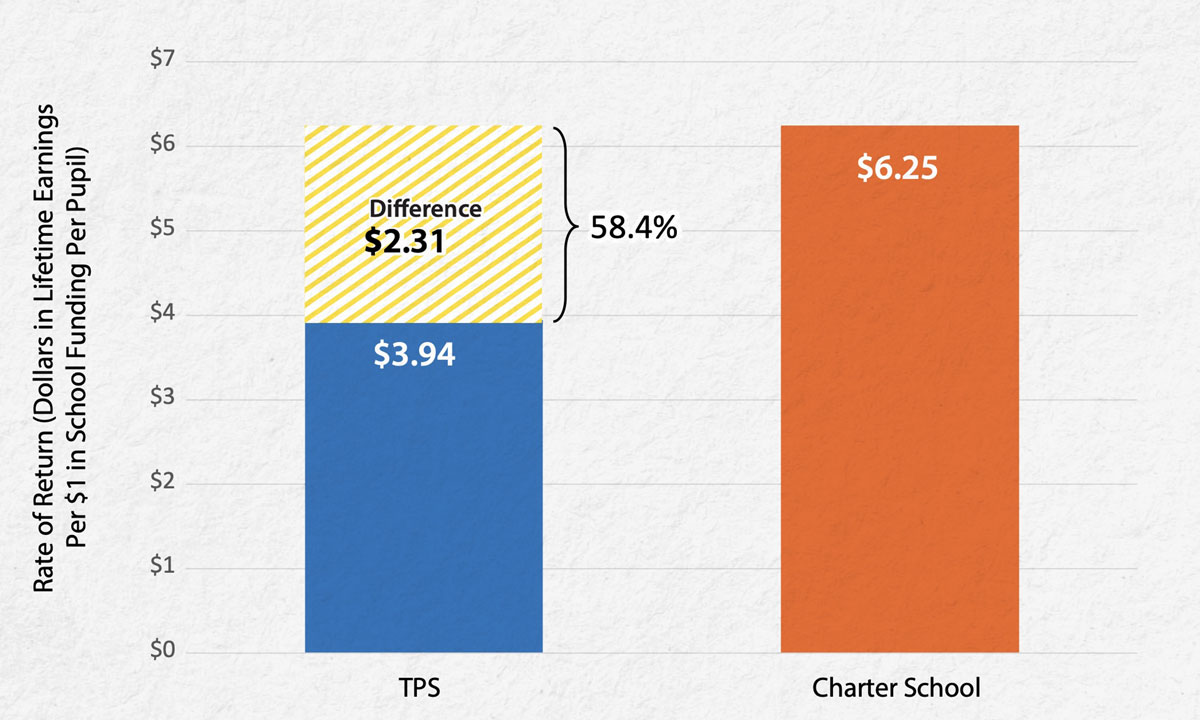New Report Finds Charters Deliver More Bang for the Buck than District Schools
Aldeman: Indianapolis charters saw faster progress in reading and math than neighboring district schools despite spending $8,000 less per pupil.

Get stories like this delivered straight to your inbox. Sign up for The 74 Newsletter
Public charter schools are more productive than traditional school districts in terms of their ability to translate a given level of investment into math and reading gains for students.
That’s the finding of a new report from researchers at the University of Arkansas. Charter schools in Indianapolis; Camden, New Jersey; San Antonio, Texas; and New York City were all particularly cost-effective.
First, the report compares spending versus achievement for traditional district and charter schools in nine cities. On average across the sample, charter schools got less money than nearby district schools. Yet charter students made greater academic gains than their peers in the traditional schools.
Next, using data showing that higher achievement is linked to greater lifetime earnings, the authors calculate precise estimates for returns on investment in public education. On average, students in traditional public schools earned $3.94 in future lifetime earnings for every $1 invested in public schools. Public schools are a good investment!
But charters were an especially good investment, the research shows. For every $1 these cities invested in charter schools, students could expect to gain $6.25 in lifetime earnings. That works out to a 58% advantage for charters for every dollar spent.
Consider the case of Indianapolis, which had the biggest charter school advantage of the nine cities in the study. Its charter schools spent nearly $8,000 less per pupil than the local district, and yet students in Indianapolis charter schools made faster progress in reading and math. In Indianapolis, every dollar spent on charters returned 106% more than the same amount invested in the city’s traditional public schools.
The report does not go into why charters are more efficient, but it would be worth a broader look. Is it merely that charters pay their teachers less money, or do they deploy staff more strategically? Are the charter school gains caused by specific academic programs or curricula, or are they tied to a culture of high expectations?
Historically, education has shied away from conversations about trade-offs and the output of different types of investments. In some corners, discussions of productivity are considered taboo or inappropriate in the context of a public good like education.
But American schools have a growing (in)efficiency problem. It’s simple math: Achievement levels are at multi-decade lows at the same time as spending and staffing levels are at all-time highs. Combine these two trends, and it’s fair to say that American schools are less productive — in an economic sense — than they’ve ever been.
OK, you might say, the math checks out, but who cares? Isn’t productivity just for pointy-headed economists? Besides, budgets are strong right now, and school districts don’t need to turn a profit, so they don’t need to engage in this type of cost-benefit thinking.
These are short-sighted arguments. For one, the good times will end, perhaps soon, and school districts will once again need to balance their budgets. And in the meantime, they’re facing growing competition from public charter schools, private schools and homeschooling. Plus, school district advocates will have an easier sell when they’re able to show that traditional schools are good stewards of public resources.
Efficiency concerns are everywhere. We care about inflation and the price of goods and services. We hunt for good deals.These concepts, so common in our everyday lives, are all too rare when it comes to education. But they shouldn’t be. With student enrollment declining and one-time federal funds about to expire, schools will need to start paying more attention to the value they’re getting from their investments. In some cities, that may mean looking to how charter schools are operating successfully with fewer resources and leaner budgets.
Get stories like these delivered straight to your inbox. Sign up for The 74 Newsletter

;)
